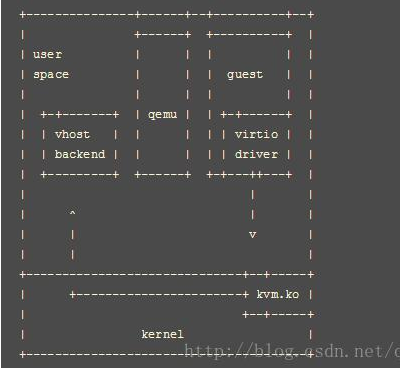vhost
virtio
e1000网卡:提供虚拟机与外界进行通信的能力。但是e1000网卡上也包含了复杂的io端口,寄存器,缓存配置,虚拟机每次收发包都会引起更多的io和mmio操作。
- 通过Virtio: 通过共享队列共享数据,减少IO,提高网络性能
- 采用virtio,需要从用户态(guest)到内核态(KVM),然后再进入用户态处理事件(qemu)。然后qemu对设备进行访问。
- 通过vhost:内核中加入了vhost-net.ko模块
- 采用vhost,只需要从用户态(Guest)陷出到内核态(KVM)。然后KVM中的vhost.net.ko模块可以直接访问宿主机上的设备。减少了一次从内核态(KVM)到用户态(qemu)的切换
- 设备在qemu中为
vhost-net
- 区分Vhost-user:用于用户态到用户态进程之间的通信(vhost是用户态和内核态之间的通信)。如果将网络设备放到用户态,实现为vhost-backend,会更加灵活。
- 要求: 所有的客户机内存分配为共享的巨页内存
- guest发出中断信号退出kvm,kvm直接和vhost-backend通信,然后网络数据将交由vhost-backend 进行处理
- 设备在qemu中对应的模块为
vhost-user-net
vhost
vhost架构的一个惊人的特性是其并没有绑定在KVM上。其仅是一个用户空间接口并不依赖于KVM内核模块。
-
通信
Guest进程与vhost工作进程通信的方式与通用的virtio设备相同。例如内核中的vhost-net模块,接收Guest发出的IO时间通知之后,访问宿主机上的设备,并将响应放入virtioqueue中,以中断的方式通知Guest。
vhost-user
1
2
3
4
5
6
7
8
|------------------------|
| vhost client |---------
|-------------------- | |
| shared memory |----| |
|-------------------- | socket
| | |
| vhost backend |---------
--------------------------
-
vhost-user 基于 C/S 的模式,采用 UNIX 域套接字(UNIX domain socket)来完成进程间的事件通知和数据交互,相比 vhost 中采用 ioctl 的方式,vhost-user 采用 socket 的方式大大简化了操作。
-
vhost-user 基于 vring 这套通用的共享内存通信方案,只要 client 和 server 按照 vring 提供的接口实现所需功能即可,常见的实现方案是 client 实现在 guest OS 中,一般是集成在 virtio 驱动上,server 端实现在 qemu 中,也可以实现在各种数据面中,如 OVS,Snabbswitch 等虚拟交换机。
-
如果使用 qemu 作为 vhost-user 的 server 端实现,在启动 qemu 时,我们需要指定 -mem-path 和 -netdev 参数,如:
1 2 3
$ qemu -m 1024 -mem-path /hugetlbfs,prealloc=on,share=on \ -netdev type=vhost-user,id=net0,file=/path/to/socket \ -device virtio-net-pci,netdev=net0
-
指定 -mem-path 意味着 qemu 会在 guest OS 的内存中创建一个文件,share=on 选项允许其他进程访问这个文件,也就意味着能访问 guest OS 内存,达到共享内存的目的。
-
-netdev type=vhost-user 指定通信方案,file=/path/to/socket 指定 socket 文件。
-
- qemu在初始化vhost-user相关设备时,会通过socket建立Vring和事件通知机制。启动之后Guest和Host通信遵循virtio方式
- qemu中的vhost-user模块将与Guest的握手结果,通过socket通知到宿主机用户态的vhost-backend
- 在guest启动后,加载virtio-net驱动,会写寄存器VIRTIO_PCI_GUEST_FEATURES,这个写操作会被kvm捕获传递给qemu。(qemu又会通知到vhost_backend)
- 当guest中virtio-net加载完成后会写VIRTIO_PCI_STATUS寄存器,这个操作同样会被kvm捕获传递给qemu
- 虚拟机驱动之后,就是host用户态的vhost-backend和Guest中的用户态进程之间的通信了(通过virtio)
- qemu中的vhost-user模块将与Guest的握手结果,通过socket通知到宿主机用户态的vhost-backend
- 通过mmap的方式把ram映射到vhost-user app的进程空间实现内存的共享
支持的vhost消息有
1
2
3
4
5
6
7
VHOST_SET_MEM_TABLE
VHOST_SET_VRING_KICK // guest通知后端的ioeventfd
VHOST_SET_VRING_CALL // 设置host用掉buffer时触发的ioeventfd
VHOST_SET_LOG_FD
VHOST_GET_VRING_BASE // 作为信号去数据平面删除vring的一个queue
VHOST_SET_VRING_ERR
...
分析

参考:
http://blog.chinaunix.net/uid-28541347-id-5786547.html
https://blog.csdn.net/qq_15437629/article/details/77899905
https://cloud.tencent.com/developer/article/1075606
https://www.cnblogs.com/ck1020/p/8341914.html
vsock
cloud-hypervisor中对virtio-vsock设备的描述
1
2
3
4
5
6
7
8
9
10
11
12
13
14
15
16
17
18
The `VsockEpollHandler` implements the runtime logic of our vsock device:
1. Respond to TX queue events by wrapping virtio buffers into `VsockPacket`s, then sending those
packets to the `VsockBackend`;
2. Forward backend FD event notifications to the `VsockBackend`;
3. Fetch incoming packets from the `VsockBackend` and place them into the virtio RX queue;
4. Whenever we have processed some virtio buffers (either TX or RX), let the driver know by
raising our assigned IRQ.
In a nutshell, the `VsockEpollHandler` logic looks like this:
- on TX queue event:
- fetch all packets from the TX queue and send them to the backend; then
- if the backend has queued up any incoming packets, fetch them into any available RX buffers.
- on RX queue event:
- fetch any incoming packets, queued up by the backend, into newly available RX buffers.
- on backend event:
- forward the event to the backend; then
- again, attempt to fetch any incoming packets queued by the backend into virtio RX buffers.
virtio-vsock设备有两个virtio queue
- 其中tx-queue负责接收前端的virtio buffer,并构造Vockpacket,发送到vsock-backend进行处理
- rx-queue:vsock-backend产生的vsock-packet,通过rx-queue发送到guest中的设备驱动
局限:
- 前后端通信时仍然需要虚拟机陷出到kvm,然后进hypervisor处理,再通知vsock-backend
vhost-vsock
结构:

只需陷出到KVM(内核态),直接通知用户态的vsock-backend
###cloud-hypervisor
以block -device为例。 在main()函数中就根据config,创建block-backend
1
2
3
4
5
6
7
if let Some(backend_command) = cmd_arguments.value_of("net-backend") {
start_net_backend(backend_command);
} else if let Some(backend_command) = cmd_arguments.value_of("block-backend") {
start_block_backend(backend_command);
} else {
start_vmm(cmd_arguments);
}
###cloud-hypervisor
vhost-user-blk
vring等协商的过程直接通知到backend
runtime: config-change等消息由后端发送到qemu,Master进行处理
1
2
3
4
5
6
7
8
9
10
11
12
13
14
15
16
17
18
19
20
21
/// Type of requests sending from slaves to masters.
#[repr(u32)]
#[derive(Clone, Copy, Debug, PartialEq, Eq, PartialOrd, Ord)]
pub enum SlaveReq {
/// Null operation.
NOOP = 0,
/// Send IOTLB messages with struct vhost_iotlb_msg as payload.
IOTLB_MSG = 1,
/// Notify that the virtio device's configuration space has changed.
CONFIG_CHANGE_MSG = 2,
/// Set host notifier for a specified queue.
VRING_HOST_NOTIFIER_MSG = 3,
/// Virtio-fs draft: map file content into the window.
FS_MAP = 4,
/// Virtio-fs draft: unmap file content from the window.
FS_UNMAP = 5,
/// Virtio-fs draft: sync file content.
FS_SYNC = 6,
/// Upper bound of valid commands.
MAX_CMD = 7,
}
-
kill event 和pause event和config change 由后端处理
-
queue event由vhost-user-bachend处理